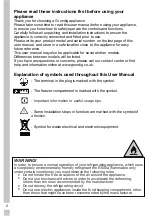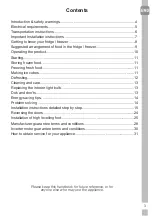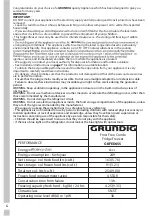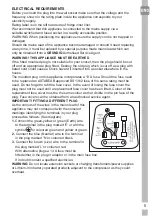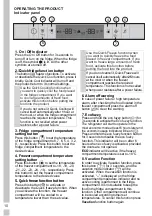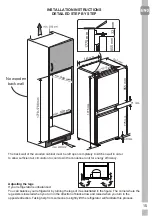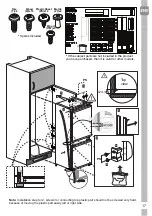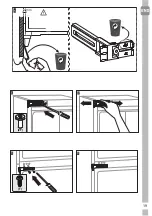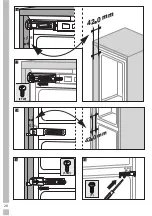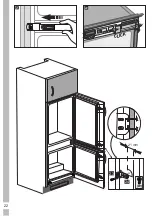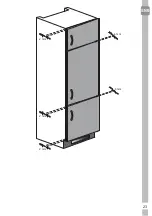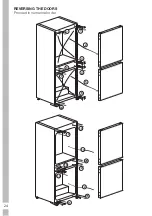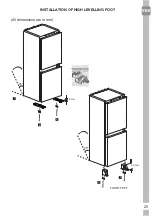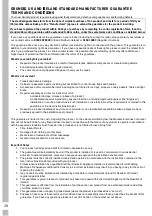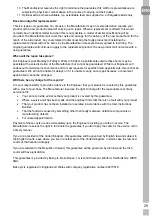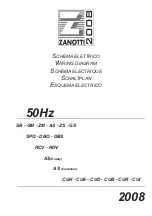
14
Don't- Store bananas in your fridge compartment.
Don't- Store melon in your fridge. It can be chilled for short periods as long as
it is wrapped to avoid it
flavouring
other food.
Don't- Store poisonous or any dangerous substances in your appliance.
It has been designed for the storage of edible foodstuffs only.
Don't- Consume food which has been stored for an excessive time in the fridge.
Don't- Store cooked and fresh food together in the same container. They should
be packaged and stored sep
a
rately.
Don't- Let defrosting food or food juices drip onto food.
Don't- Leave the door open for long periods as this will make the appliance
more costly to run and cause excessive ice formation.
Don't- Use pointed sharp edged objects such as knives, forks to remove the ice.
Don't- Put hot food into the appliance. Let it cool down
f
i
rst.
Don't- Put liquid-
f
i
lled bottles or sealed cans containing carbonated liquids into
the freezer as they may burst.
Don't- Exceed the maximum freezing loads (
4
.25
kg in any 24 hours) when
freezing fresh food.
Don't- Give children ice-cream and water ices direct from the freezer. The low
temperature may cause 'freezer burns' on lips.
Don't- Freeze
f
i
zzy drinks.
Don't- Try to keep frozen food which has thawed, it should be eaten within
24 hours or cooked and refrozen.
Don't- Remove items from the freezer with wet hands.
Don't- Close the freezer door before placing the compartment cover in its place.
Don’t- Leave frozen food at room temperature to thaw; the best way to defrost
food is to put it in the fridge to thaw slowly. Make sure you avoid defrosting
food or food juices drip onto other food.
ENERGY SAVING TIPS
1-
Ensure your appliance is installed in a well ventilated area. If the ambient
temperature is low (but in no case lower than
10
degrees C), then the energy
saving will be more. In this case, check temperatures of fridge and freezer
compartments with an accurate thermometer and lower the
temperature
setting
if necessary.
2-
Ensure the time between buying chilled/frozen food and placing them in your
appliance is kept at minimum, particularly in summer. We recommend you
use
a cool bag or a special carrier bag to carry frozen food.
3-
Do not leave the door (s) of your appliance open longer than necessary and
ensure they are closed properly after each opening.
4-
Defrost your appliance regularly (see "
DEFROSTING
")
.
5-
Defrost frozen food in the fridge compartment, so that frozen food acts as
an
ice pack to assist cooling in the fridge.
PROBLEM SOLVING
If the appliance does not operate, check whether:
•
The plug is inserted properly in the socket and that the power supply is on. (To
check the power supply to the socket, plug in another appliance)
.
•
The fuse has blown/circuit breaker has tripped/main distribution switch has
been turned off.
•
The temperature control has been set correctly.
• New plug is wired correctly if you have changed the fitted moulded plug.
If the appliance is still not operating after the above checks, please refer to the
section on “
How to Obtain Service
”.
Please ensure that above checks have been made as a charge will be made if
no fault is found.
Summary of Contents for GKFED455
Page 1: ...Refrigerator Installation User instructions GKFED455 ENG...
Page 16: ...16 775 mm 40 mm 71 mm 855 mm 1778 1788 mm...
Page 18: ...18 1 2 3 4...
Page 19: ...19 8 9 T 5 4 mm 6 7 2T...
Page 20: ...20 14 13 T 1TW 12 42 0 mm 42 0 mm 10 11 42 0 mm 42 0 mm 1TW...
Page 21: ...21 20 W 2 0 mm 18 15 17 16 1TW 42 0 mm 42 0mm 19 CLICK...
Page 22: ...22 21 1 2 22 CLICK 23 90 o 21 mm W 24...
Page 23: ...23 2 mm 2 mm 2 mm 4 mm 4 mm...
Page 24: ...REVERSING THE DOORS Proceed in numerical order 24 1 9 1 19 17 20 14 16 13 12 15 11...
Page 26: ...26 4 5 REAR FEET 45...
Page 27: ...555 mm 27 1836 mm 855 mm 32 mm 71 mm 540 mm 545 mm 91 mm 775 mm 1836 mm 855 mm...


